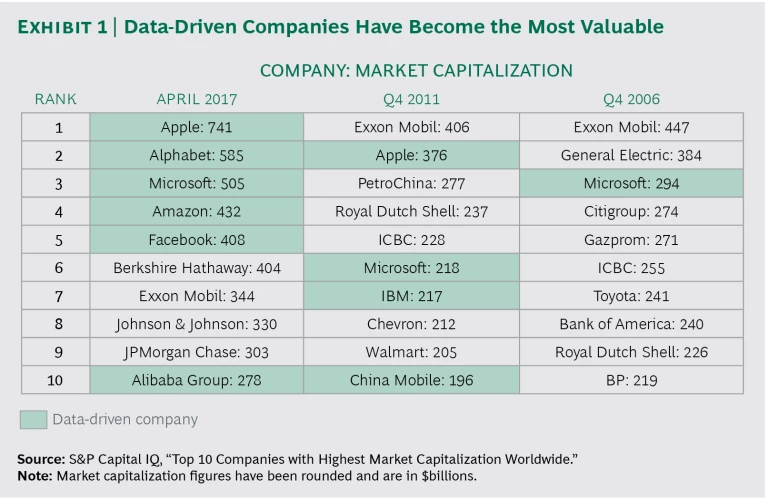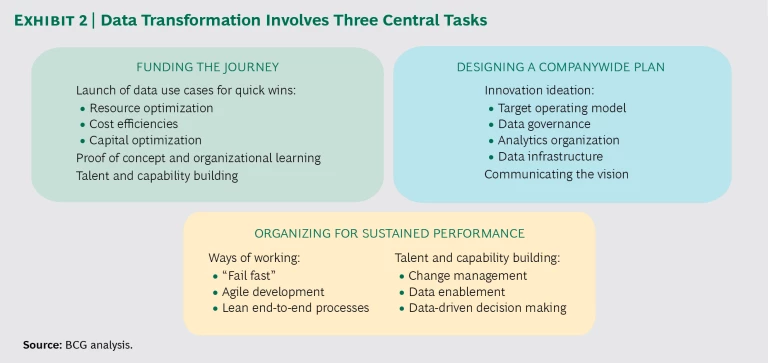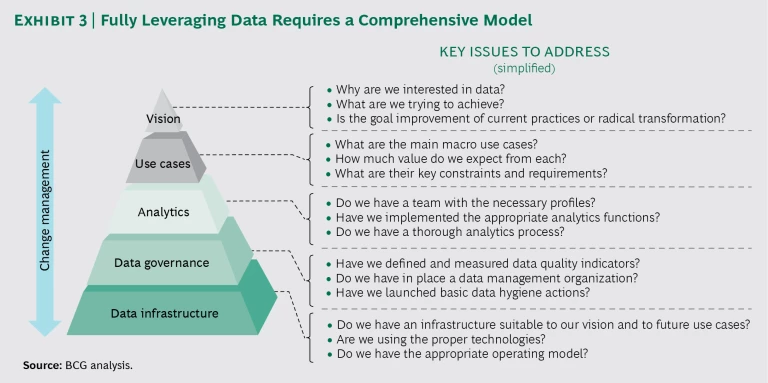Data-driven transformation is becoming a question of life or death in most industries. But initiatives to embed data in operations throughout a company often fail. This is because companies start by trying to reinvent their core IT systems—a multiyear effort that can run to hundreds of millions of dollars. Sadly, most of this money is wasted, because these massive centralized efforts take far too long. When the rules of business are being rewritten on a quarterly basis, companies need an approach to transformation that is agile, focused on results, and manageable.
Most CEOs recognize the power of data-driven transformation. They certainly would like the 20% to 30% EBITDA gains that their peers are racking up by using fresh, granular data in sales, marketing, supply chain, manufacturing, and R&D. And they may even dream of joining the ranks of data-driven companies that have shoved aside traditional players among the world’s most valuable companies. (See Exhibit 1.)
Yet CEOs are right to wonder how their organizations—where managers and executives already complain about a lack of data skills and where overburdened IT systems seem unlikely to be able to handle a tenfold increase in company data—can pull off such a transformation. These CEOs want to find a reliable way to move their companies into the data-driven future so that they can set up their companies to survive—and not put them in danger in the process.
There is a better way to approach data transformation. In our experience, these initiatives can succeed only if they are cost effective, incremental, and sustainable. Transformations should start with pilots that pay off in weeks or months, followed by a plan for tackling high-priority use cases, and finishing with a program for building long-term capabilities. Working with clients across industries, we have developed a three-phase approach to data-driven transformation. It starts with small-scale, rapid digitization efforts that lay the foundation for the broader transformation and generate returns to help fund later phases of the effort. (See Exhibit 2.) In the second and third phases, companies draw on knowledge from their early wins to create a roadmap for companywide transformation, “industrialize” data and analytics, and build systems and capabilities to execute new data-driven strategies and processes.
This three-step approach is faster, less costly, and more likely to succeed than a system-wide overhaul. Using existing data systematically and combining it with external data (from social networks, for example) for marketing or customer issue resolution can deliver fast results. We have seen companies achieve 15% to 20% of the potential of a full data-driven transformation in six to nine months.
Use quick wins to learn and fund the digital journey . In this first phase, companies identify the low-hanging fruit—discrete, rapid digitization efforts that can deliver quick wins. These projects immediately move the needle on performance in a key area—sales support or supply chain, for example. And rather than taking years, implementation occurs in months and starts paying back almost immediately. The pilot projects show that the company can benefit from digitization, and they provide important lessons in how to roll out digital transformation across the company. Crucially, the extra value that the quick wins create can help pay for longer-term efforts, potentially making the transformation self-funding.
Design the companywide transformation. In the second phase, which can begin while the first initiatives are still underway, the company draws a roadmap for company-wide transformation. This involves building a portfolio of opportunities—identifying and prioritizing functions or units that can benefit most from transformation. It also involves locating and starting to address roadblocks to transformation. During the design phase, companies also invest in framing and communicating the vision for the transformation to build support for needed changes, and they invest in systems to industrialize data analytics—making analytics a resource for every operation.
Organize for sustained performance. With a detailed roadmap in place and with the experience and funding available from the early projects, the company is ready to undertake a full-fledged digital transformation. In this phase, digital and data-driven processes and work methods spread to every corner of the company. Employees learn to work across silos to enable data-driven processes, and leaders make the organizational changes necessary to sustain the new approaches. The company creates a data-driven culture by investing in capabilities to use analytical insights and by launching a change management program to embed new mindsets, behaviors, and ways of working.
Use Quick Wins to Learn and Fund the Digital Journey
Moving a big company in a new direction is a huge challenge for management. The best-conceived and most urgent transformation programs—digital or otherwise—are sometimes no match for organizational inertia. This may explain why 70% of publicly announced transformation programs fail to meet the company’s ambition, its timeline for the transformation, or both.
But large organizations can overcome resistance and build the enthusiasm needed for change to succeed if they approach transformation in the right way. By starting a transformation journey with a small number of quick initiatives that demonstrate what can be achieved by using new approaches, companies greatly increase their chances of eventual success.
Leaders should choose quick-win initiatives carefully, on the basis of several critical criteria: they must have a high chance of success, a significant and rapid payback, and visibility across the company. A major industrial company, for example, started by digitizing high-profile processes, including inventory management. (See “Building Momentum Through Pilots.”)
Building Momentum Through Pilots
A large industrial company contemplated a massive digital transformation to increase its efficiency and to compete more effectively in markets where producers have limited pricing power. The company did not want to tie up capital in a massive change program and wait years for a payback. To avoid that outcome, the company first identified a few quick-win initiatives that could pay off within a month or a quarter.
The first initiatives it selected were in inventory management and capacity optimization—analyzing output and shifting production to sites that made the most profitable products. For these quick wins, the company used static data and created one-off solutions. But the projects led to significant savings and more sales of high-profit items, which generated immediate value. In nine months, quick wins generated $20 million in value. Once the projects based on static data were up and running, the company went back and built the systems it needed to manage these processes and functions continuously, using real-time data flows.
Applying the lessons from its early wins, the company has created a roadmap for ten major data transformation initiatives in areas as varied as demand forecasting and managing the outbound sales force. The company has also made plans for new companywide resources to support data-driven approaches and make them sustainable, including building a data lake. And it has begun identifying new data-driven business models. The overall goal for the transformation is to unleash $200 million in value over three to five years and to help the company raise its EBITDA margin by 2% to 4%.
Initial projects may be limited in scope, but it is essential that they succeed and serve as a convincing advertisement for the benefits of digital transformation. For this reason, companies should not only choose projects carefully but also be pragmatic about execution. It is best to avoid projects that would require fundamental changes in data handling—projects that would entail building a new data repository, for instance. Companies should use agile methodologies to build any new analytics models, with short sprints and tight timelines for developing a minimum viable product that can be tested and used to define additional requirements and refinements.
Quick-win projects should require no more than four to six months to complete, and their value should be demonstrable within weeks. During the quick-win phase, companies can build their ability to focus and execute swiftly and to work across silos—critical capabilities for pursuing large-scale transformation efforts. Quick wins can also energize and inspire managers and employees who have seen change initiatives bog down in the past.
Design the Companywide Transformation
As soon as it is clear that the early digital transformation projects are off to a solid start, the company can start preparing the roadmap for extending digital transformation across the enterprise. This starts with a high-level vision, which company leaders translate into a portfolio of initiatives (or use cases) to be rolled out in a logical order, on the basis of factors such as size of impact and competitive needs or opportunities. Then the company must agree upon some underpinnings of digital operations—analytics, data governance, and data infrastructure. (See Exhibit 3.) Creating a roadmap for use cases and projects to build data infrastructure and other resources needed for data-driven operations can not only make the transformation run more smoothly but also ensure that these investments pay. (See “Driving Fast Value from Data Transformation in Logistics.”)
Driving Fast Value From Data Transformation in Logistics
For more than 30 years, a major global logistics company led its industry in the use of information technology, and its leaders believed that data was its competitive differentiator. The company took the long-term view and had spent more than five years implementing a new ERP system that cost hundreds of millions of dollars. But after massive investments of time and money, the company could not demonstrate that it had gained any competitive advantage in cost or revenue.
Then the company took a new, agile tack. This time it created a detailed roadmap for transformation based on two primary considerations: an examination of the data needed monthly, weekly, and in real time to optimize functions or operations and to generate the most impact for the company; and an assessment of the systems and data already available to fill the newly identified business needs. On the basis of this roadmap, the company began a series of pilot projects, using benchmarking data to optimize important cost drivers such as fuel consumption, maintenance, and labor. Another project aimed to improve pricing performance by accessing data such as customer P&L through new analytics.
Over the course of three years, the company systematically completed the list of projects for every major value driver in the business. After dozens of projects in areas such as pricing, fuel consumption, and network, the company went from sitting in the middle of the pack in operating performance to becoming the industry leader on EBIT performance.
Before attempting to define its vision, a company needs to have a thorough understanding of where it stands in terms of data, digitization, and current capabilities. As a preliminary step, then, the company should quickly and objectively assess its situation and gauge how its capabilities stack up against best practices in its industry. One option in this area is a diagnostic developed by BCG that weighs 21 factors in assessing a company’s starting point in data and analytics capabilities and assets, backing up the assessment with extensive, continually updated benchmarks.
Five Critical Steps for a Successful Data Transformation
The assessment of data capabilities gives the company the information it needs to carry out five critical steps.
Build a vision. When planning a data-driven transformation, a company must set the appropriate vision for its business. For some companies, the transformation will mostly be about using data to improve operations and to compete more effectively. For others, it might involve building new business models. The visioning exercise should include identifying the macro use cases—the most important projects that the company wants to undertake.
Select the portfolio of initiatives. Using its vision and its list of macro projects for reference, companies can create a full list of transformational initiatives. The company should use a structured ideation process to compile the list, and it should use a rigorous prioritization methodology to set the schedule. Factors such as data availability, regulatory compliance, and technical or modeling difficulty, as well as dollar value, customer benefits, and strategic importance must also be weighed.
Devise an analytics operating model. Before investing in new data analytics capabilities, a company should specify how it wants the data analytics function to work. After analyzing its internal capabilities, it can decide which components of the analytics function to seek in-house and which to outsource.
Establish data governance. To ensure the quality and integrity of the data it will use for business decisions—with and without human intervention—a company must have strict governance rules and a data governance structure. It must also define data quality and establish ways to continually improve it.
Define data infrastructure. A company moving toward data transformation should address the following questions: Can our current infrastructure support our future data value map? Should we make or buy? Should we go to the cloud? Do we need a data lake? What role should our legacy IT systems play in our data transformation? The company should design a data platform (or data lake) that can accommodate its product map and should use that platform to progressively transform its legacy systems.
Industrialize Data Early to Ensure Full Transformation and Long-Lasting Impact
While the company continues to sketch the transformation roadmap—if not sooner—it needs to begin industrializing its data and analytics. This means setting up a way to standardize the creation and management of data-based systems and processes so that the output is replicable, efficient, and reliable. Digital systems are the new means of production, and they need to have all the attributes of industrial machinery, including reliability and consistency. Above all, the company needs to have a way to guarantee that it generates and harnesses high-quality data and has an efficient data environment.
A centralized or hub-and-spoke operating model can ensure clear, consistent strategy and execution; rationalize investments; and ensure economies of scale. Business units and functions that will rely on new data-driven systems and processes should have input into system design and data quality assurance, but these groups must rely on the core data management organization for data governance.
The second element in industrializing data consists of determining the appropriate architecture to support data analytics across the organization. A flexible open architecture that can be updated continuously and enhanced with emerging technologies is generally the best option. Rather than embracing an end-to-end data architecture, companies should adopt a use-case-driven approach, in which the architecture evolves to meet the requirements of each new initiative. The data governance and analytics functions should collaborate to create a simplified data environment; this will involve defining authorized sources of data and aggressively rationalizing redundant repositories and data flows.
Organize for Sustained Performance
As is the case with any change program, the success of a data transformation is measured by sustained results—and those will not materialize without making the company and its culture data centric. To prepare its organization for a digitized future, the company needs to move on four fronts: creating new roles and governance processes, instilling a data-centric culture, adopting new ways of working, and cultivating the necessary talent and skills.
Many companies may be capable of managing this change on their own; but if a company faces competitive challenges that require a rapid transition, or if it is far behind in digitization or lacks the resources and capabilities to manage the transformation, it may benefit from adopting a build-operate-transfer model (which we discuss below). This involves creating a dedicated organization—usually run with the guidance of an outside expert partner—that takes over the organizational change effort.
Define new roles and governance rules. To ensure the sustainability of the benefits it obtains through the adoption of new digital processes, a company needs to make clear who has responsibility for building and running new systems and maintaining specific types of data—and how to manage those people. The changes begin at the top: senior leaders should adopt data-driven objectives and cascade those goals throughout the organization. Top management may want to set up data councils to extend the work to all sectors of the organization and to carry it out more effectively. The company should promote data awareness by using data champions to disseminate data-driven practices. The company can set up a change management function under the chief data officer, too. The data awareness effort should extend to all work, including tasks that the digital transformation does not directly affect. For example, the company might create data-based metrics for functions such as HR, perhaps measuring the number of applications processed per job filled.
Build a data-first culture. Not everyone needs to become steeped in data analytics or learn to code in order for digital transformation to work. However, everyone does need to adopt a less risk-averse attitude. To move quickly and to continually find new ways to apply data, companies should behave a bit like software development operations, embracing a test-and-learn culture that encourages experimentation, accepts—even celebrates—failure, and is always learning. Companies can also encourage the desired cultural change through organizational moves, such as creating internal startup units where employees can focus on experimentation or co-locating data labs within operating units. The company can also promote the new culture by using cross-functional teams that share data across silos, thereby encouraging openness and collaboration throughout the organization.
Adopt agile ways of working. The entire organization does not have to become expert in agile, but the company can adopt many of the tactics of the agile method and use them in everyday operations to increase the organization’s responsiveness and adaptability. It can establish scrum teams with squads and tribes to tackle specific problems—and accelerate the pace with weekly sprints, rather than months-long efforts. Teams and groups can implement morning standups and weekly demos (reviews) as part of governance. Overall, the new ways of working should emphasize autonomy and reduce hierarchy.
Cultivate the necessary talent and skills. For data-based transformation to work, the company must have talent with the right skills to execute data-driven strategies and manage data-based operations. This presents a workforce planning challenge, starting with assessing current employees and defining future needs. The company should create an inventory of the talents and skills that its employees will need, and it should identify where the gaps are in the current workforce. Companies will need to retrain current employees, hire new talent, or use a partnership to get the right capabilities. To recruit people with digital skills, the company may need to rethink the value proposition it offers—work, opportunity, rewards, career path, and so on—in relation to what tech companies offer.
Consider the build-operate-transfer model. In some instances, a company may need to adopt bolder steps to accelerate its data-driven transformation. This may be because it is starting from far behind its competitors or because it lacks the capabilities and resources needed to drive the transformation internally. In such situations, using the build-operate-transfer model makes sense. Adapted from the construction industry, this model involves creating a stand-alone organization in partnership with an outside vendor that has the expertise to run transformation initiatives. The organization focuses on managing transformation efforts and is staffed by employees from both the firm and the outside partner. It takes responsibility for setting up and running the use case projects and other elements of the transformation. Over time, as projects are completed, the partner withdraws its employees. Eventually it transfers all work and resources back to the company, and the stand-alone organization dissolves.
The promise of data-driven transformation has captured the imagination of leaders throughout the business world and is driving change in the public and social sectors, too. Executives are inspired by the idea of using data to make better decisions and digitizing all sorts of processes to improve performance. They are also motivated by fear that they won’t be able to keep up with competitors who are ahead of them in data-driven digital transformation. These forces can encourage companies to try to achieve sweeping, companywide change to go digital—which can lead to counterproductive overreaching. This contest will not be won by making huge bets. The winners will be agile, pragmatic, and disciplined. They will move fast and capture quick wins, but they will also carefully plan a transformation roadmap to optimize performance in the functions and operations that create the most value, while building the technical capabilities and resources to sustain the transformation.













